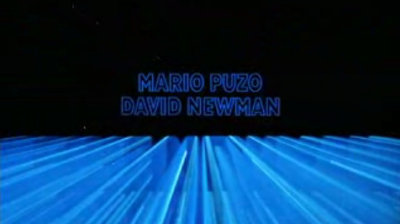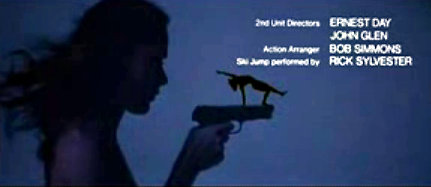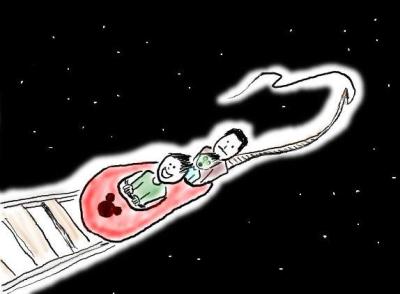 |
I received 85 credits on The Sci Fi Sounds Quiz How much of a Sci-Fi geek are you? |
| Take the Sci-Fi Movie Quiz cheap digital camera | |
Thanks to David for tipping me to this.
Americlecticintellectica
 |
I received 85 credits on The Sci Fi Sounds Quiz How much of a Sci-Fi geek are you? |
| Take the Sci-Fi Movie Quiz cheap digital camera | |
Thanks to David for tipping me to this.
At first I was going to confine this blog-a-thon to screenwriting. “Write about a movie whose script was good but not great, and explain how you would improve it” were the original instructions. Then I thought, why not extend it to all creative endeavors? And so I shall.
 No easy targets please; I don’t want to hear how Meatballs III could have benefited from the addition of some talking animals. Of course it could have benefited from the addition of some talking animals. Any change would have been an improvement. (Except for casting someone other than Patrick Dempsey in the lead role, now that he’s all hot and stuff.)
No easy targets please; I don’t want to hear how Meatballs III could have benefited from the addition of some talking animals. Of course it could have benefited from the addition of some talking animals. Any change would have been an improvement. (Except for casting someone other than Patrick Dempsey in the lead role, now that he’s all hot and stuff.)
Also, no mere technical problems please. It’s not very interesting to hear that you would take better care to keep the boom mike out of the shot, or aim the camera away from the shadow of the helicopter it’s in. And don’t simply catalog the faults of an otherwise good work of art (as I have done on this blog from time to time). Anyone can criticize; only a few can correct.
No, please stick to movies (et al.) that are already pretty good and require only some creative input from you to realize their full potential.
For example:
One day many years ago I turned on the TV in the middle of a World War II spy thriller, 36 Hours, starring James Garner and Rod Taylor. (Spoilers follow.) James Garner wakes up in an American army hospital five years after the war; he’s been in a coma. He’s delighted to hear that the Allies won. The D-Day invasion, which was still in the planning stages when his coma began, was a big success. His doctors and nurses chat him up on the subject, testing his memory.
In fact the hospital and its staff, the newspaper showing the date to be 1950, even James Garner’s greying temples, are all an elaborate ruse by the Germans. The war is still on. James Garner had been drugged and abducted and is being tricked into revealing secrets about the Normandy invasion, which the Germans know is imminent. We learn this about twenty minutes or so from the point where I started watching. James Garner realizes it himself soon after — and then must continue to play dumb and plant misinformation to counter the secrets that (he realizes with horror) he’s spilled. Very suspenseful.
Those of you who know the film can predict what’s coming. Years later I saw it again, this time from the beginning, and I saw nearly a full half hour of setup and exposition I hadn’t seen before — absolutely none of which was needed to appreciate the remainder of the film. In that first half hour we see that James Garner is a dedicated Army intelligence officer. We see him come by the D-Day knowledge that will later be of such interest to his interlocutors. We see him get a seemingly inconsequential paper cut which is what tips him off later to the fact that not so much time has passed. And then we see him abducted and the German ruse put into effect.
In my first creative writing class in high school, my teacher, Mr. San, taught that after writing a story, we should throw away the first act, because it will only ever contain plodding exposition that the reader would prefer to find out along the way anyway. That should have been done with 36 Hours. There’s nothing in the first half hour that we can’t infer from the rest of the film; and the abduction of an Army intelligence officer is a much smaller first-act dramatic development than the whopping revelation that everything we’ve seen so far has been a lie.
One such article, “‘Drilling Up’ — Some Look to Space for Energy,” appeared recently from the Associated Press. It describes a joint effort between the U.S. Department of Defense and the island nation of Palau to demonstrate the feasibility of receiving power from an orbiting satellite. The satellite will collect solar energy during its ninety-minute orbit, storing it up in order to beam it down to a receiver on Palau as it passes overhead. It will send a million watts of power during a five-minute window.
The article touts it as a forward-thinking alternative-energy project that will benefit at first the citizens of Palau and later the world. But nowhere in the article, or indeed in other articles of this ilk, are any red flags raised about placing in the Pentagon’s hands a solar death ray that can incinerate targets from orbit.
Now I don’t wish to impugn the Pentagon’s motives. I am sure their ambitions have everything to do with altruistically improving the standard of living for every person on earth and nothing to do with a lust for high-tech war toys. But if you or I built something that could store up three hundred million joules of energy and then deliver it all in a five-minute burst to any spot on earth, you could forgive the people of the world harboring a little concern.
You’d think that science writers could follow the technological implications of the things they write about. Hell, for this story all they need to do is watch some James Bond.
I remember some national magazine or other publishing a humorous “interview” with Yoda in the summer of 1980, when The Empire Strikes Back was new and so was Yoda. Yoda answered questions on the topics of the day in his cockeyed syntax. (I remember the piece closing with Yoda asking, “Any more questions, have you?” and the interviewer responding, “Yes: who shot J.R.?“) Among the subjects covered in the interview was Superman the Movie — specifically, its opening credits, in which spectacularly animated names whoosh though interstellar space. Yoda said something like, “Oh yes, flying letter storms. Get them all the time on Dagobah, we do.”
That the article should touch on the opening credits — the credits — of another, unrelated movie more than a year and a half old, at a time when Empire was eclipsing everything else in the pop culture landscape, should give you some idea of the impression that Superman‘s credits made. They nearly upstaged the entire movie that followed, and decades later it’s those credits, set to John Williams’ unabashedly rousing march, that hold up better than most of the rest of the film.

That was almost all I had on the subject of opening credits until I mentioned to my wife Andrea that I would be participating in this blog-a-thon. Andrea, who routinely professes ignorance of and disinterest in film lore, proceeded to rattle off a series of terrific suggestions that I am embarrassed not to have come up with myself. So herewith, a few words on a few more memorable opening credits.
No discussion of memorable opening credits would be complete without mentioning the James Bond series. (Not that I’m aiming for anything like completeness.) The first film, Dr. No, doesn’t count, but it’s interesting in the way it doesn’t count: its credits are jazzy and abstract, which might have set the tone for the whole series if it had begun in the late 50’s rather than in the early 60’s. But Camelot and the Playboy era rode up alongside the James Bond series and the tone became somewhat different. The opening credits for the next film, From Russia With Love, created the template for the rest of the films: an imperfectly seen, mostly unclad beauty writhing athletically on screen. Later films, most of them with their title sequences designed by Maurice Binder (who had done the first two too) had variations on this theme: female silhouettes dancing and multiplying across the screen. When handguns appeared, the formula was complete. The pinnacle must have been The Spy Who Loved Me: Roger Moore and some nude women in silhouette, performing gymnastics on the silhouettes of handguns.

Maurice Binder is long gone, alas, but the latest Bond credits, for Casino Royale, are superb: paying homage to the old formula while modernizing with some (non-obnoxious) computer graphics and a considerably more serious tone emphasizing the consequences of violence (as silhouettes battling Bond disintegrate into heart, diamond, spade, and club symbols) rather than the glamour of girls and guns.

 The Pink Panther (1963) had an opening credits sequence so memorable it spawned its own cartoon series — even though the film itself was a live-action farce about a diamond heist, not about an animated, rose-hued feline.
The Pink Panther (1963) had an opening credits sequence so memorable it spawned its own cartoon series — even though the film itself was a live-action farce about a diamond heist, not about an animated, rose-hued feline.
Robert Altman’s The Player opens with credits over a long, complex tracking shot — a single take several minutes long, shot with a single camera following several characters and actions in various locations around a complex set. During this sequence, one character mentions the brilliant tracking shot that opens Orson Welles’ Touch of Evil, making it a self-referential joke with plenty of inside-Hollywood references, which is exactly what the rest of the film delivers, too.
But no opening credits capture in microcosm both the psychology and the structure of the film to follow better than those in Memento. A Polaroid of a dead man fades to white. The movie is running in reverse and the Polaroid is un-developing. As the credits end, the blank film disappears into a camera, the flash bulb pops, a bullet flies back into a gun, and the dead man comes back to life.
The Polaroid has been taken as a memento of a violent deed committed by Leonard Shelby who, because of a head injury, lacks the ability to form new memories. Like the Polaroid-in-reverse, his experiences fade in just a few minutes. His life is defined by Polaroids like these, which he snaps and organizes to keep track of people, places, and events that he can’t remember on his own. The story is told in two tracks: one whose scenes are in black and white and appear in chronological order; and another, intercut with the first, whose scenes are in color and, like the fading Polaroid, appear in reverse.
This is the year 2008. The number 2008 has four prime factors: 2×2×2×251. Last year had three (3×3×223) as does next year (7×7×41).
The year 2000 had 7 prime factors (2×2×2×2×5×5×5), which was the most since 1984, which also had 7 (2×2×2×2×2×2×31). 1944 had 8 (2×2×2×3×3×3×3×3), which we won’t see again until 2016 (2×2×2×2×2×3×3×7). 1920 had 9! (2×2×2×2×2×2×2×3×5.)
Those of us who can make it until 2048 will get to see an 11-factor year (2×2×2×2×2×2×2×2×2×2×2) and the first year since 1024 that’s a power of two, which is a big deal to computer nerds like me.
The most recent prime-number year was 2003 and the next is 2011. The most recent twin-prime years were 1997 and 1999, and the next are 2027 and 2029.
What is the significance of all this? Not a damn thing. But you read it all with interest, didn’t you?
Today is my dad’s birthday! In honor of it, here is a reproduction of a web page I created for him on Father’s Day, 2001.
Life With Dad

There once was a man

His name was Daddy.

He had a son

(And sometime caddy).

He helped him to grow

And have fun on the way

That’s why the son

Is a man today.

The son hopes that he

Can be like his dad

So that someday his own kids

Will have one like he had.